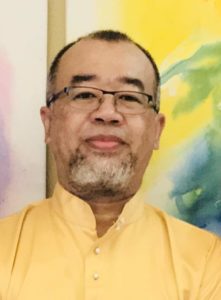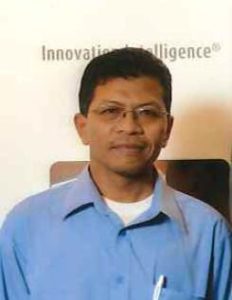Keynote Speaker 1
Professor Ir Dr Shahrum bin Abdullah
Universiti Kebangsaan Malaysia
Title: Ballistic Performance of the Steel-Aluminium Sandwich Panel for Armoured Vehicle
Synopsis:
This work focusses on the durability performance of the lightweight laminated panel consisting high strength steel and aluminium alloy for armoured vehicle application. The recent trend in military industry is to incorporate lightweight materials into the armoured vehicle designs to reduce the vehicle weight to improve the vehicle maneuverability, without sacrificing the performance and safety. Layering aluminium plate with high strength steel has become an interest in reducing the vehicle weight and improving the ballistic resistance. AR500 and AA7075-T6 were chosen in designing laminated panel to achieve intended 20-30% weight reduction. Layering these materials involves joining process and a series of mechanical tests to study its durability performance. Joining between these two materials have been investigated using both brazing method and adhesive bonding method. Mechanical tests such as bending tests, drop weight tests and ballistic tests were performed to assess the strength of the laminated panel. Results showed that adhesive bonded laminate panel exhibited 50% higher strength that that through the brazing process. Meanwhile, the penetration patterns found numerically are nearly similar to that from the ballistic tests and thus has validated the finite element models developed. The study on application of this laminated plate shall be extended using higher level of threat for hard armour vehicle panel.
Keynote Speaker 2
Professor Dr Kheng Lim Goh
Newcastle University Research & Innovation Institute, Singapore (NewRIIS)
Title: Putting Humpty Dumpty back together again: Physics of composite repair
Synopsis:
While it is possible to strengthen and stiffen the epoxy composite with continuous carbon fibres (commonly refered to as CFRPs), what can we do to toughen the epoxy matrix? This question is important because the matrix component functions to reduce abrasion between fibres by keeping the fibres apart but also to absorb impact energy-ruptures under impact. Although the CFRPs can be made to high specific strength and stiffness, they are also susceptible to damage by projectiles. Damage occurs when the project impacts at a direction perpendicular to the plane of the laminate, notably interlaminar failure, polymer matrix rupture, fibre-matrix debonding, carbon fibre pull-out and carbon fibre fracture. The answer to how we can toughen the CFRP further can be found in the hierarachical architecture of soft connective tissue where we have learnt that the soft gel-like proteoglycan-rich matrix in tendons can be toughened by lining up with nanometer elastic fibres. By an analogy to tissue, it follws that the microscopic epoxy matrix in epoxy composite may also be lined with nanocomposites of epoxy/carbon nanofibre.
This talk is intended to connect the current fundamental understandings of findings of polymer composites reinforced by carbon nanotubes and carbon fibres to mission critical industry applications such as commercial aircraft structures. The fundamental understandings will address the interaction of carbon nanotubes/fibres with polymer matrix (that implicate the structure-function relationship). Current findings of the structural monitoring of the performance of these polymer composites and mechanical damage in mission critical industry are highlighted. These will be discussed in the context of fundamental understandings that informed the current findings of how carbon nanotubes (CNTs) dispersed uniformly and aligned along the fibre-matrix interface can enhance the interfacial toughness. The strategies may involved introducing CNT into the composite during manufacturing or during repair of damaged sites. CNTs can be physically bond with polymeric matrix. However, at the lengthscale of CNT, modeling the elasticity and failure behavior of CNTs and the local environment of the CNT, and how the underlying mechanics affect the overall composite material becomes a complex task. Current approach addresses multi-scale modeling strategies involving multiple spatial and temporal scales in hierarchical or concurrent manner. This talk will highlight the multiscale modeling techniques in studying the mechanical response of CNTs in a polymeric matrix in between fibres, such as continuum stress-transfer approach, quasi-continuum approach and molecular dynamics simulation, and how these approaches are integrated with analytical and numerical micromechanics models to predict the average macroscopic properties of the polymer composite. Of note, the demand for CFRP in mission critical areas then requires robust structural health monitoring (SHM) of the the composite structures, especially after repair. Traditionally, the SHM of CFRP structures involves non-destructive testing methods which are performed off-line, e.g. when the aircraft is not in-service. Recently, there are studies to integrate SHM systems within composite structures for in-service application. While CNT is known for its capability for reinforcing a material, its conductivity properties in a polymeric matrix may also be exploited for SHM for damage sensing capability.
Keynote Speaker 3
Mr Noor Hisham bin Ismail
Perusahaan Otomobil Nasional Berhad (PROTON), Malaysia
Title: A New Engineering Simulation Paradigm
Synopsis:
Since the first application of general engineering simulation technology in 1960s, computer-aided-engineering (CAE) has progressed from a technology accessible to mathematical and computing experts to a standard tool in an engineer’s portfolio, used to solve a range of design and engineering problems. CAE simulation based decision support tools facilitate solution development, validation and testing for systems and individual elements of systems. Worldwide automotive business environment of the 21st century is seeing a strong focus on strategic goals for improving competitiveness. The vehicle attributes must be fuel-efficient, safe, technologically savvy, robust, durable, affordable and manufactured quickly on the line without defects. At the same time, it must meet increasingly stricter government regulations. Within the last 10 years, the vehicle must also incorporates fast-evolving electronic, communication and software technology that hardly existed before. To confront these challenges, automakers and their supply chain have emphasized on the CAE simulation approach to address some of today’s market expectations: fuel-efficiency standards, performance comforts, potential warranty issues, and the transition to hybrid and electric vehicles. They also pursue big ideas, disruptive technology, such as autonomous vehicle.
Today, more than 85 percent of CAE analysis performed by automotive companies requires a range of analysis tools to study mechanical forces, dynamic fluid flows, noise and vibrations, vehicle dynamics, thermal effects and electromagnetic performance. Each of these tools requires specialized training to master. Consequently, the product development team typically includes a series of physics specialists, trained in simulating a single physical force, who pass off design projects sequentially instead of in parallel. Due to the lack of available specialized CAE analyst, the engineering simulation market growth becomes limited. Such conditions defeat the purpose of leveraging the power of CAE simulation to innovate, fulfill consumer demands, comply with stringent regulatory demands, and meet development time, cost and performance targets. In addition, although developed for decades, current CAD and CAE software tools are not effectively adapted to confront modern productivity challenges which also couple with steady decrease of automotive product life cycles duration. Each tool was created to fit the needs of the respective engineers job function, CAD for design and CAE for calculation or simulation engineers. As a result, engineers have to move back and forth multiple times a day, from design to numerical simulation to optimization. Accounting the ever increasing competitive pressure of the automotive industry, a new paradigm for engineering simulation is needed.
The presentation shall start the focus with the current scenario of CAE approach in increasing fidelity for system level structural simulation, co-simulation & multi-physics, optimization and robust design. All these give rise to a new engineering simulation paradigm in the coming decades. The new paradigm is about making engineering simulation widely available and appropriate to support improved decision making throughout the entire life-cycle of the ever-increasing complexity of engineered products and processes. In essence, a new engineering simulation paradigm is a culture of collaborative modeling, analysis/optimization, immersive man-machine interactions, common visualizers, and standards-based cognitive knowledge sharing systems for experiencing real-time multi-physical response simulation. In order to establish the environment towards the next generation of engineering simulation, alliances must be formed across industry, academia, government, professional organizations, and Cax vendors to develop harmonized visions for the new engineering simulation paradigm.



